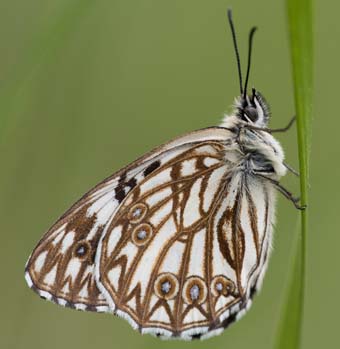
Researchers at the Cavanilles Institute for Biodiversity and Evolutionary Biology of the University of Valencia Science Park have participated in the preparation of the first atlas of genetic diversity of butterflies in the Iberian Peninsula. The results of this study, led by the Institute of Evolutionary Biology (CSIC-UPF), have just been published in the journal ‘Scientific Reports’, by the ‘Nature’ publishing group.
The team led by researcher Roger Vila has been sequencing the mitochondrial DNA from 228 known species and main populations of butterflies throughout the peninsula since 2006. The result is a comprehensive work with some 3,500 genetic sequences of all species, which have been added to those already existing in the rest of Europe. The article is complemented by 277 pages of supplementary materials including images and 80 maps of lineage distribution.
Entomologist-biologist Sergio Montagud, from the Cavanilles Institute, says that his group is analysing and testing "a very modern tool: using a short piece of DNA to identify the species. This technique, known as barcoding of life, is taking great value in current studies of biodiversity".
HIDDEN GENETIC WEALTH
"The discovery of this variability in the DNA barcoding for a group of insects that is so well known, or at least that is what we thought, has been a great surprise for us", emphasizes Montagud. In short, "we couldn’t imagine that many of the species flying in Europe, particularly in the Iberian Peninsula, would hide such genetic richness, which suggests the existence of cryptic species", adds the scientist at the University Valencia.
Montagud explains that the divergence of these lineages, in many cases, matches biogeographic patterns, "which reinforces the logic of these results. And in other cases, cryptic species share the same habitats and sites, a fact that opens new doors to research into the biological barriers that lie behind these species”.
"We assume that there may be differences in copulatory organs, in reproductive behaviour or pheromones, or in choosing specific habitats. Thus, the resolution of these biological patterns requires further study", argues Sergio Montagud.
IMPROVING CONSERVATION
The findings of this study will be very useful to direct future studies on diversity of butterflies, ecological interactions between species and to improve their conservation by prioritising and avoiding mixing of divergent lineages. "Knowing the exact number of species and differentiating between them is important to preserve them appropriately", says Roger Vila, researcher of the Spanish Research Council at the Institute of Evolutionary Biology.
According to him, it will also allow us to "identify any sample butterfly through its DNA, either from small parts (legs or wings), eggs and caterpillars, or even traces of butterflies that have been eaten by other animals”.
28% OF SPECIES REMAIN TO BE DISCOVERED
The comparison between the genetic sequences obtained and the data on European butterflies already known indicates that there could be up to 28% of species yet to be discovered. These would have gone unnoticed until now because it is difficult to distinguish them from others morphologically very similar. In fact, one of the objectives of the study was to see if there may be yet unknown species.
These could be, scientists say, cryptic species, i.e., species that are morphologically very similar and, therefore, were thought to be the same. But DNA analyses reveal that, in fact, a significant part of the populations have had a long independent evolutionary history. Put another way, "this implies that within that 28% of species, there may be others that have gone unnoticed", says Vila. "Now it is time for the arduous task of studying each case in detail to see which species are really new and which are simply subspecies. I don’t think they all are, by no means, but I can anticipate that we have compelling data of some new species", he asserts.
"We see nature with our human eyes and many butterflies that look alike cannot be told apart because they have distinctive features that are invisible to us. But DNA analyses can reach a level of differentiation which was unthinkable a few years ago", according to the researcher of the Institute of Evolutionary Biology.
BUTTERFLIES REDUCED BY HALF IN TWENTY YEARS
In parallel, there are very clear data showing that butterflies are in danger, similar to bees. We know that the population of butterflies in Europe has halved in the last twenty years, "and all this considering that, at that time, the population must have already been lower than in previous decades. We are really in a race against time to identify and protect biodiversity", says Roger Vila.
European butterflies have traditionally been one of the most studied groups of insects by professionals and amateurs. Since the days of Linnaeus, in the mid-eighteenth century, many groups of enthusiastic lepidopterists have sought and described each subspecies, varieties and local forms of butterflies on the continent. Often, the same varieties have been described by different authors and, later, have had to be reviewed. "Today it is considered difficult to find new varieties that have not been described before; however, genetic analyses show that nearly a third of species still hide unknown diversity", insists Montagud.
If this situation is occurring with butterflies, the researcher at the University of Valencia wonders what might be happening, for example, with less known or poorly studied groups of arthropods. "We can expect big surprises with the application of these genetic techniques on groups such as myriapods, crustaceans, coleoptera, mites, etc., for which existing cryptic diversity can be enormous. And the situation should reach even greater parameters in fauna as biodiverse and as little studied as is the case of tropical forests", suggests Montagud from the Cavanilles Institute.
Dinca, V., Montagud, S., Talavera, G., Hernández-Roldán, J., Munguira, M.L., García-Barros, E., Hebert, P.D.N. & Vila, R. (2015) DNA barcode reference library for Iberian butterflies enables a continental-scale preview of potential cryptic diversity. Scientific Reports.
http://www.nature.com/srep/2015/150724/srep12395/full/srep12395.html
Last update: 3 de august de 2015 07:00.
News release


















